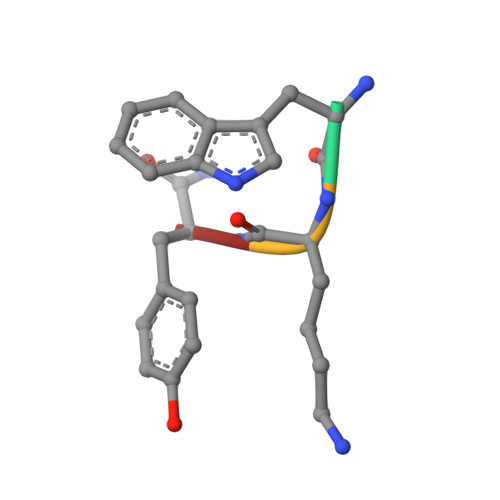Structure-Based Optimization of the Terminal Tripeptide in Glycopeptide Dendrimer Inhibitors of Pseudomonas aeruginosa Biofilms Targeting LecA.
Kadam, R.U., Bergmann, M., Garg, D., Gabrieli, G., Stocker, A., Darbre, T., Reymond, J.-L.(2013) Chemistry 19: 17054-17063
- PubMed: 24307364
- DOI: https://doi.org/10.1002/chem.201302587
- Primary Citation of Related Structures:
4LKD, 4LKE, 4LKF - PubMed Abstract:
The galactopeptide dendrimer GalAG2 ((β-Gal-OC6H4CO-Lys-Pro-Leu)4(Lys-Phe-Lys-Ile)2Lys-His-Ile-NH2) binds strongly to the Pseudomonas aeruginosa (PA) lectin LecA, and it inhibits PA biofilms, as well as disperses already established ones. By starting with the crystal structure of the terminal tripeptide moiety GalA-KPL in complex with LecA, a computational mutagenesis study was carried out on the galactotripeptide to optimize the peptide-lectin interactions. 25 mutants were experimentally evaluated by a hemagglutination inhibition assay, 17 by isothermal titration calorimetry, and 3 by X-ray crystallography. Two of these tripeptides, GalA-KPY (dissociation constant (K(D))=2.7 μM) and GalA-KRL (K(D)=2.7 μM), are among the most potent monovalent LecA ligands reported to date. Dendrimers based on these tripeptide ligands showed improved PA biofilm inhibition and dispersal compared to those of GalAG2, particularly G2KPY ((β-Gal-OC6H4CO-Lys-Pro-Tyr)4(Lys-Phe-Lys-Ile)2Lys-His-Ile-NH2). The possibility to retain and even improve the biofilm inhibition in several analogues of GalAG2 suggests that it should be possible to fine-tune this dendrimer towards therapeutic use by adjusting the pharmacokinetic parameters in addition to the biofilm inhibition through amino acid substitutions.
- Department of Chemistry and Biochemistry, University of Berne, Freiestrasse 3, 3012 Berne (Switzerland), Fax: (+41) 31-631-80-57.
Organizational Affiliation:




















